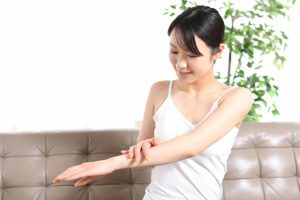2025.01.20
[Doctor Supervised] Does Oxidative Stress Lead to Photoaging? Causes, Prevention, and Improvement Methods Explained
When exposed to ultraviolet (UV) rays, the human body generates reactive oxygen species (ROS). These ROS increase oxidative stress levels in the body, damaging the skin’s epidermis and dermis, leading to the formation of dark spots and wrinkles. This phenomenon is called photoaging.
Preventing photoaging requires stopping the rise in oxidative stress caused by UV rays and boosting the activity of the body’s antioxidant system to eliminate ROS. Effective measures include protecting the skin from sunlight and consuming antioxidants.
This article delves into the relationship between oxidative stress and photoaging, and provides specific prevention strategies such as UV protection and antioxidant intake.

Photoaging refers to changes in the skin, such as dark spots, wrinkles, and sagging, caused by prolonged exposure to sunlight. While the harmful effects of UV rays are widely known, oxidative stress also plays a significant role in photoaging.
Two types of UV rays, UVA and UVB, reach the Earth’s surface. UVB, with a shorter wavelength, damages the epidermis and causes inflammation, dark spots, and discoloration. UVA, with a longer wavelength, penetrates the dermis, damaging collagen and reducing skin elasticity, leading to wrinkles and sagging.
Both UVA and UVB generate ROS, such as hydrogen peroxide and singlet oxygen, within cells. These ROS oxidize skin cells, trigger melanin production (causing dark spots), and increase oxidative stress. High oxidative stress levels reduce collagen in the dermis and decrease its elasticity and flexibility. Oxidized DNA activation also contributes to wrinkle formation and accelerates aging. These cumulative effects result in deep wrinkles characteristic of photoaging.
While both involve aging, photoaging and intrinsic aging differ in their effects. Intrinsic aging refers to natural changes such as skin thinning and the development of wrinkles and sagging as a result of aging.
In contrast, photoaging is characterized by the formation of deep wrinkles as a protective response to UV exposure. Unlike intrinsic aging, the skin does not thin but instead becomes stiff and loses elasticity. Additionally, photoaged skin exhibits irregular pigmentation and darker patches compared to the pale, thin appearance of intrinsically aged skin.
A clear comparison can be observed by examining sun-exposed areas like the face and hands versus less-exposed areas like the chest and abdomen. Despite aging at the same rate, sun-exposed areas develop deep wrinkles, while protected areas develop fine lines.

Photoaging progresses with prolonged exposure to sunlight (UV rays). To prevent it, minimizing direct UV exposure to the skin and reducing oxidative stress are essential. While completely avoiding UV exposure in daily life is impractical, protecting exposed skin and using sunscreen to minimize damage are effective strategies.
Additionally, consuming antioxidants through food or supplements can help mitigate accumulated oxidative stress. A dual approach—preventing oxidative stress and alleviating its effects—is key to preventing photoaging.
The most effective way to prevent photoaging is to avoid UV exposure. While short-term exposure may not cause significant damage, cumulative daily exposure can lead to long-term harm. Protect the face, which is particularly vulnerable, with umbrellas and hats. Use UV-blocking umbrellas with high UV-cut rates for optimal protection. For arms, which umbrellas may not fully cover, wear cardigans or arm covers.
Don’t overlook the eyes, which are also susceptible to UV damage. Protect them with UV-blocking sunglasses. Remember, UVA can penetrate clouds and windows, reaching the skin and causing wrinkles and sagging. Cloudy weather may require even more caution than clear skies due to scattered light. Stay vigilant and take protective measures regardless of the weather or location.
Related Article: Does Sun Exposure Increase Oxidative Stress? (Louis Pasteur Medical Research Center Antioxidant Laboratory)
UV rays not only come from above but also reflect off surfaces, making sunscreen essential even when using umbrellas or hats. Sunscreens are labeled with SPF and UVA values, indicating their protection against UVB (causing dark spots) and UVA (causing wrinkles and sagging). While higher values offer stronger protection, they may also increase skin irritation. Use stronger sunscreens for outdoor activities and lighter ones for daily use.
Apply sunscreen evenly to prevent uneven tanning, and reapply every 2–3 hours, especially after sweating. When reapplying, ensure the skin is dry for optimal coverage. At the end of the day, remove sunscreen thoroughly with specialized cleansers or oils to avoid residue.
Complete avoidance of UV exposure is impossible, so consuming antioxidants to reduce oxidative stress is an effective measure. Antioxidants include vitamin C, vitamin E, polyphenols, and carotenoids.
Vitamin C is abundant in kiwi and bell peppers, while vitamin E is found in nuts like almonds and green and yellow vegetables. Polyphenols, such as anthocyanins in blueberries and catechins in green tea, are natural antioxidants. Carotenoids, present in green and yellow vegetables and seaweeds, include lycopene found in tomatoes.
Supplements can help fill dietary gaps. When choosing supplements, prioritize those with scientifically proven data rather than relying solely on attractive claims or numbers.
UVA and UVB rays in sunlight generate ROS like hydrogen peroxide and singlet oxygen, increasing oxidative stress. This process causes dark spots and wrinkles, characteristic of photoaging. Unlike intrinsic aging, photoaging leads to deeper wrinkles, making thorough UV protection essential.
Use umbrellas, hats, and sunscreen to block UV rays from all angles, and consume antioxidants like vitamin C and polyphenols to further protect the skin. Consistent UV protection is crucial for maintaining healthy skin. Start taking small steps today for a brighter, more youthful tomorrow.